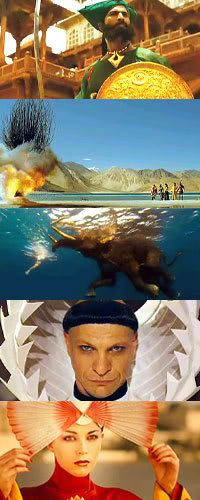 THE FALL (dir. Tarsem Singh, India/UK/USA, 2006, 117 mins.) I think it's ART. But that's a tough call, since its creator is a television commercial director, with very little available for comparison. Tarsem Singh (now "renamed" as simply Tarsem) directed only one other feature, THE CELL, and one exceptional music video for R.E.M. ("Losing My Religion"), outside of his commercial work. I can only guess that he has been successful enough in advertising to allow him a project that is as broad and indulgent as THE FALL.
THE FALL (dir. Tarsem Singh, India/UK/USA, 2006, 117 mins.) I think it's ART. But that's a tough call, since its creator is a television commercial director, with very little available for comparison. Tarsem Singh (now "renamed" as simply Tarsem) directed only one other feature, THE CELL, and one exceptional music video for R.E.M. ("Losing My Religion"), outside of his commercial work. I can only guess that he has been successful enough in advertising to allow him a project that is as broad and indulgent as THE FALL.  It is stunning to look at. STUNNING! The project was filmed against and among some of the world's most unique architecture, in no less than twenty three countries, across five continents. (In fact, at one point, as I felt as if I were watching a narrative of BARAKA, we cut to a scene with the Balinese Monkey Chant!) The temples, mosques, palaces and deserts, painted cities are all of such unique grandeur (WHERE is that outrageous stairway?!), I felt ignorant in not being able to name them as they appeared. Against these backdrops, Tarsem has enlisted Eiko Ishioka as costumer designer, who also designed THE CELL for him. Ishioka's work is as ethereal and stunning as always! She must dress actual period and the storytelling, and she has the unique ability to dress fantasy, but not so enigmatically so as not to become science fiction.
It is stunning to look at. STUNNING! The project was filmed against and among some of the world's most unique architecture, in no less than twenty three countries, across five continents. (In fact, at one point, as I felt as if I were watching a narrative of BARAKA, we cut to a scene with the Balinese Monkey Chant!) The temples, mosques, palaces and deserts, painted cities are all of such unique grandeur (WHERE is that outrageous stairway?!), I felt ignorant in not being able to name them as they appeared. Against these backdrops, Tarsem has enlisted Eiko Ishioka as costumer designer, who also designed THE CELL for him. Ishioka's work is as ethereal and stunning as always! She must dress actual period and the storytelling, and she has the unique ability to dress fantasy, but not so enigmatically so as not to become science fiction.  The screenplay is where Tarsem runs into criticism. The initial setting is in a 1920's Los Angeles hospital where a stuntman lies paralyzed from a stunt gone bad. He befriends a small immigrant girl, who is there with a broken her arm. (Both of them are injured from falls.) He is despondent and weaves a story in order to manipulate the girl into helping him. As he tells her the story, it is played out in HER imagination, resulting in a stunning sequence of settings. The use of these settings are nearly stream of consciousness, as the stuntman stumbles through his story and is reinterpreted by the the Romanian girl's imagination. (How else would an elephant arrive to help our heroes swim from a reef to shore?) The nearly random series of events is a little confusing as far as bringing him to his goal, unless you allow the imagery to seduce and manipulate you as it does the little girl. And it is how stories manipulate us that seems to be the heart of Tarsem's film.
The screenplay is where Tarsem runs into criticism. The initial setting is in a 1920's Los Angeles hospital where a stuntman lies paralyzed from a stunt gone bad. He befriends a small immigrant girl, who is there with a broken her arm. (Both of them are injured from falls.) He is despondent and weaves a story in order to manipulate the girl into helping him. As he tells her the story, it is played out in HER imagination, resulting in a stunning sequence of settings. The use of these settings are nearly stream of consciousness, as the stuntman stumbles through his story and is reinterpreted by the the Romanian girl's imagination. (How else would an elephant arrive to help our heroes swim from a reef to shore?) The nearly random series of events is a little confusing as far as bringing him to his goal, unless you allow the imagery to seduce and manipulate you as it does the little girl. And it is how stories manipulate us that seems to be the heart of Tarsem's film. Catinca Untaru plays the little girl with a nearly off-putting innocence. For my taste, she lacks the emotional scars that her character's history suffered. It may not be fair to compare the performance to Victoire Thivisol in PONETTE, or Brigitte Fossey in FORBIDDEN GAMES. However, in those two performances, the little girls displayed real emotional pain (Thivisol almost alarmingly so!), that might be considered true manipulation, however authentic the performance might be. It is not that Untaru is not genuine. It is just a matter of having cast such an innocent in a role that carries such a heavy emotional burden. In other words, she is CUTE. Almost annoyingly so. However, Tarsem does seem to understand that a little bit of that can go quite far. The pacing and editing into the storytelling seems to skim the fat off the cream, as it were.
Catinca Untaru plays the little girl with a nearly off-putting innocence. For my taste, she lacks the emotional scars that her character's history suffered. It may not be fair to compare the performance to Victoire Thivisol in PONETTE, or Brigitte Fossey in FORBIDDEN GAMES. However, in those two performances, the little girls displayed real emotional pain (Thivisol almost alarmingly so!), that might be considered true manipulation, however authentic the performance might be. It is not that Untaru is not genuine. It is just a matter of having cast such an innocent in a role that carries such a heavy emotional burden. In other words, she is CUTE. Almost annoyingly so. However, Tarsem does seem to understand that a little bit of that can go quite far. The pacing and editing into the storytelling seems to skim the fat off the cream, as it were.  Lee Pace plays the crippled stuntman. He is an exceptional performer and travels from one role to the next, nearly unrecognizably. Here, he has been given a nice challenge that extends beyond just narrating the story, but becoming a part of it, as he weaves into the darker recesses of his depression. He strikes a surprising heroic, yet tragic figure in the fantasy, and a rather tragic heel and sad manipulator in reality.
Lee Pace plays the crippled stuntman. He is an exceptional performer and travels from one role to the next, nearly unrecognizably. Here, he has been given a nice challenge that extends beyond just narrating the story, but becoming a part of it, as he weaves into the darker recesses of his depression. He strikes a surprising heroic, yet tragic figure in the fantasy, and a rather tragic heel and sad manipulator in reality. So, with those elements, all of which are unrepentantly and indulgently tossed together for optimal emotional effects, Tarsem's film has come under scrutiny for its obvious manipulation. But, as the final frames roll, that his POINT! Tarsem plays with the idea of what editing images together can do to trigger emotional response in the audience. Further, Tarsem's background in commercial advertising comes into incredible use, as he is able to strike an immediate nerve within a single frame. His use of "motion picture" allows the frame to breathe and move. The series of images then gather together for his ultimate effect. It could be argued that he has assembled not so much a motion picture, but a slide show gallery of imagery. If I were to argue that, it would be that the camera is fairly frozen in place in the tableaux. The cinematography by Colin Watkinson is gorgeously framed, but his frames lack movement. However, the argument in support for Tarsem's cinematic vision is the little girl's dream sequence after her second fall, which is spectacularly realized by animators Christoph and Wolfgang Lauenstein. The short sequence is a surreal and authentic break from the production design and pacing of the rest of the film. It would seem that Tarsem is saying that the only honest reality of our lives is in our dreams. Everything else is as manipulative as cinema.
So, with those elements, all of which are unrepentantly and indulgently tossed together for optimal emotional effects, Tarsem's film has come under scrutiny for its obvious manipulation. But, as the final frames roll, that his POINT! Tarsem plays with the idea of what editing images together can do to trigger emotional response in the audience. Further, Tarsem's background in commercial advertising comes into incredible use, as he is able to strike an immediate nerve within a single frame. His use of "motion picture" allows the frame to breathe and move. The series of images then gather together for his ultimate effect. It could be argued that he has assembled not so much a motion picture, but a slide show gallery of imagery. If I were to argue that, it would be that the camera is fairly frozen in place in the tableaux. The cinematography by Colin Watkinson is gorgeously framed, but his frames lack movement. However, the argument in support for Tarsem's cinematic vision is the little girl's dream sequence after her second fall, which is spectacularly realized by animators Christoph and Wolfgang Lauenstein. The short sequence is a surreal and authentic break from the production design and pacing of the rest of the film. It would seem that Tarsem is saying that the only honest reality of our lives is in our dreams. Everything else is as manipulative as cinema. Maxxxxx says
Maxxxxx says
re THE FALL: "Such a pretty bird!"
Friday, May 30, 2008
The Fall (or Swimming With Elephants?)
Subscribe to:
Post Comments (Atom)



















 Pseudomyxoma Peritonei (Huh???)
Pseudomyxoma Peritonei (Huh???) Fluidtoons! By Brett W. Thompson!
Fluidtoons! By Brett W. Thompson!
 THE EVENING CLASS (by Michael Guillen)
THE EVENING CLASS (by Michael Guillen) Television Without Pity!
Television Without Pity! John Rutherford's Blog for COLT Studio Group
John Rutherford's Blog for COLT Studio Group



No comments:
Post a Comment